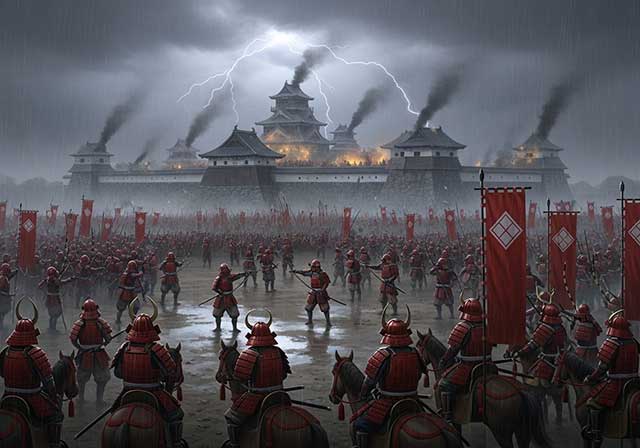
After the defeat of the Takato and Oi clans in the campaigns of 1544–1546, the Takeda clan had only one rival left in the Saku region: Kasahara Kiyoshige. His stronghold was Shiga Castle, located northwest of Utiyama Castle.
The decision to march
In July 1547, Takeda Shingen convened a council of war, which decided to launch a campaign against Kasahara. Shingen sent a letter to Shiga Castle, offering Kiyoshige the choice of either surrendering to the Takeda clan or “blaming himself.” Kiyoshige rejected the offer, hoping for help from his father-in-law, Uesugi Norimasa, who owned Hirai Castle in Kozuke Province and held the position of kanrei, advisor to the shogun of the Kanto region.
Preparations for the siege
After receiving the refusal, Shingen assembled an army of at least 5,000 men (according to other sources, 7,000 or even 10,000) and advanced from Kai Province.
Shingen was accompanied on this campaign by his generals: Itagaki Nobukata, Amari Torayasu, Yokota Takatoshi, Tada Mitsuyori, Hara Minokami, Obu Hyobu, Oyamada Nobuari, and others.
On July 20, the army reached Inariyama Castle in the Saku region. According to some sources, Takeda's vanguard was already in the vicinity of Shiga Castle on July 9, but the first skirmishes with the defenders did not occur until July 24, when the main forces arrived.
Preparations by the defenders
Kasahara Kiyoshige prepared for the siege as best he could. The castle was full of supplies, and the water problem was solved by the presence of two wells inside the walls. Uesugi Norimasa sent him a detachment of 100 elite archers, who arrived just before the siege.
Kiyoshige was also joined by relatives — Takada Noriyori, commandant of Sugawara Castle, and his son Yoritada. They brought a small detachment of warriors. Noriyori was a renowned strategist in the service of Uesugi, and Kiyoshige had high hopes for him.
According to some sources, Murakami Yoshikiyo and Oi Sadataka also sent help, but their numbers are unknown. In any case, the defenders' forces remained small: no more than 500 men (according to other sources, about 1,000, including civilians).
First attacks
Shingen made his bet on Sakurayama Castle, located two kilometers west of Shiga Castle. On July 24, Takeda's army began an assault, but was unsuccessful. Engineering troops were brought in, and several hundred workers began digging a tunnel to collapse the castle walls. However, the rock proved too hard, and after several days of futile efforts, the sappers were sent back to Kai. On July 26, two new attacks were launched, but the defenders repelled them.
Waiting for help
Kiyoshige understood that he could not hold back the superior enemy indefinitely and continued to wait for help from Uesugi Norimasa. The latter did indeed organize an expedition: a 3,000-strong army under the command of General Kanae (Kuragano) Hidekage. According to the Koyogunkan source, there were 20,000 men, but this figure is clearly exaggerated. In early August, Hidekage's army entered the Saku region via the Usui Pass.
The Battle of Odaihara
Upon learning of Hidekage's army's approach, Shingen ordered his generals—Itagaki Nobukata, Amari Torayasu, Yokota Takatoshi, Tada Mitsuyori, Hara Minokami, Obu Hyobu, and Naito Masatoyo—to intercept the enemy. On August 6, about 5,000 soldiers under the command of Itagaki Nobukata moved into the Odaihara Valley. The remaining 2,000, led by Shingen himself, continued the siege of the castle.
Takeda's army suddenly attacked Hidekage's troops. The battle lasted three to five hours and ended in the complete defeat of the Uesugi army. Hidekage himself fled and hid in the mountains. Different sources provide different data on casualties: Myōhōji-ki mentions 15 officers and 3,000 soldiers killed (clearly an exaggeration), while Kohakusai-ki and Kōyōgunkan mention 1,219 heads taken in the first attack and another 4,306 in the second. The heads were impaled on spears and displayed around Shiga Castle to demoralize the defenders.
The final battles
Kiyoshige realized that no help was coming, but refused to surrender. On August 10, Takeda's troops captured the outer fortifications and set fire to the towers and buildings. Soon, all lines of defense fell, except for the last one.
On August 11, the final assault began. The battle was fierce and bloody. The samurai Ogihara Katsuaki (1509–1581) was the first to break into the hommaru (the main courtyard of the castle), earning the status of ichiban-nori. He personally fought Kasahara Kiyoshige and took his head. Koide Etzen-no-kami killed and beheaded Takada Noriyori.
Most of the defenders—about 300 people—were killed, including Kiyoshige, Noriyori, Yoritada, and the entire Yoda family. Most of those who survived were non-combatants. Kasahara Fuzin, Kiyoshige's wife, refused to become a concubine of the victors and was executed.
Casualties and consequences
Takeda's losses are estimated at several hundred people. Kanhasshu kosenroku gives the figure of 2,143, probably including the wounded. The triumphant victory over Kasahara Kiyoshige finally broke the resistance to the Takeda clan's expansion in the Saku region.
See also
-
The Siege of Hara Castle

The Shimabara Rebellion of 1637–1638, which culminated in the siege of Hara Castle, was the last major uprising of the Edo period and had serious political consequences.
-
Battle of Tennoji

The confrontation between Tokugawa Ieyasu and Toyotomi Hideyori during the “Osaka Winter Campaign” ended with the signing of a peace treaty. On January 22, 1615, the day after the treaty was signed, Ieyasu pretended to disband his army. In reality, this meant that the Shimazu forces withdrew to the nearest port. On the same day, almost the entire Tokugawa army began filling in the outer moat.
-
Siege of Shuri Castle

The Ryukyu Kingdom was established in 1429 on Okinawa, the largest island of the Ryukyu (Nansei) archipelago, as a result of the military unification of three rival kingdoms. In the following years, the state's control spread to all the islands of the archipelago.
-
The Siege of Fushimi Castle
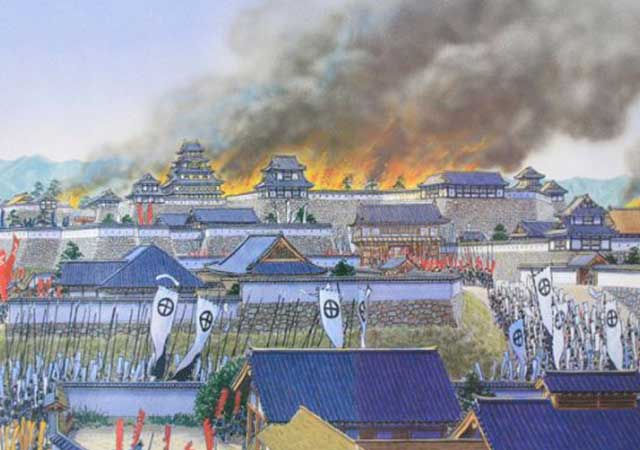
Fushimi can perhaps be considered one of the most “unfortunate” castles of the Sengoku Jidai period. The original castle was built by Toyotomi Hideyoshi in the southeast of Kyoto in 1594 as his residence in the imperial city.
-
The Siege of Otsu Castle
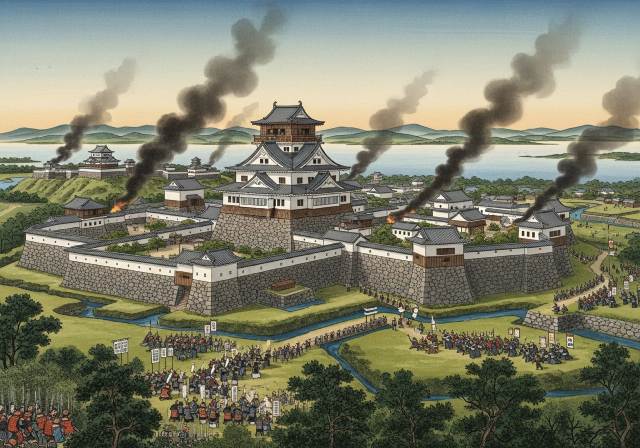
The siege of Otsu Castle was part of the Sekigahara campaign, during which the so-called Eastern Coalition, led by Tokugawa Ieyasu, fought against the Western Coalition, led by Ishida Mitsunari. Otsu Castle was built in 1586 by order of Toyotomi Hideyoshi near the capital Kyoto, on the site of the dismantled Sakamoto Castle. It belonged to the type of “water castles” — mizujō — as one side of it faced Japan's largest lake, Lake Biwa, and it was surrounded by a system of moats filled with lake water, which made the fortress resemble an island.
-
The Siege of Shiroishi Castle
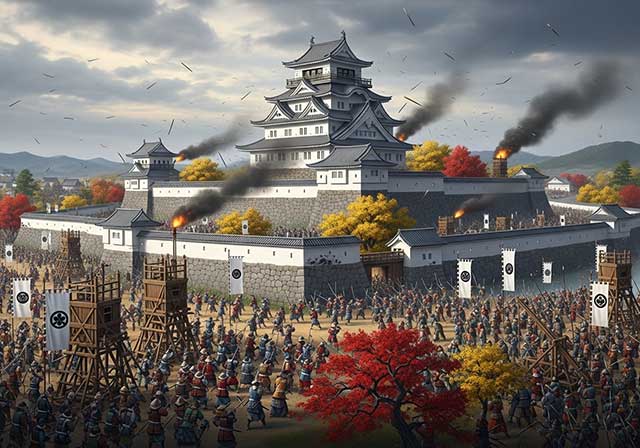
The siege of Shiroishi Castle was part of the Sekigahara campaign and took place several months before the decisive battle of Sekigahara. The daimyo of Aizu Province, Uesugi Kagekatsu, posed a serious threat to Tokugawa Ieyasu's plans to defeat the Western Coalition, and Ieyasu decided to curb his actions with the help of his northern vassals. To this end, he ordered Date Masamune to invade the province of Aizu and capture Shiroishi Castle.
-
The Second Siege of Jinju Castle
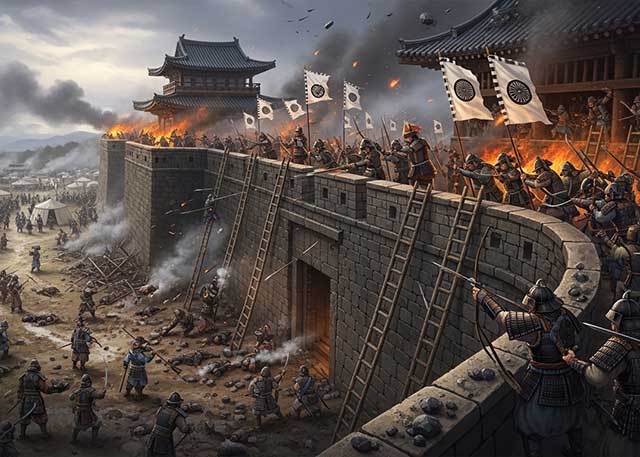
During the two Korean campaigns of the 16th century, the Japanese repeatedly had to capture enemy fortresses and defend occupied or constructed fortifications from the combined Korean and Chinese forces. Among all the operations of that time, the second siege of Jinju Castle is considered the most interesting from the point of view of siege warfare.
-
The Siege of Takamatsu Castle
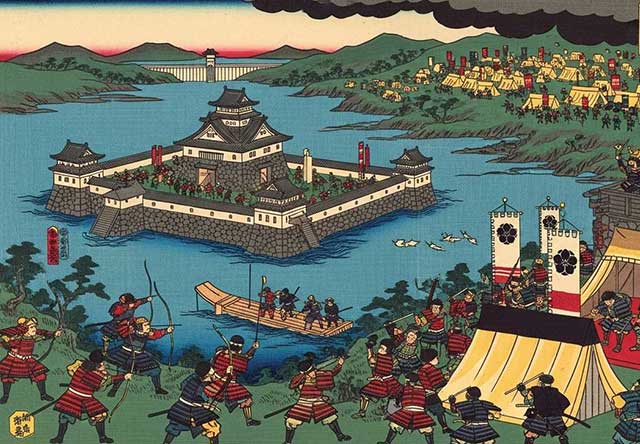
The siege of Takamatsu Castle in Bitchu Province is considered the first mizuzeme, or “water siege,” in Japanese history. Until then, such an original tactic had never been used.

